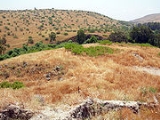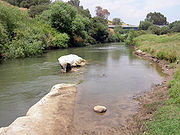
Bnot Ya'akov Bridge
Encyclopedia

's Daughters) is a bridge across the Jordan River on Highway 91
Highway 91 (Israel)
Highway 91 is an east-west highway in northern Israel and the Israeli-occupied Golan Heights. It extends through the Jordan Rift Valley and the central Golan Heights. It begins in the west at Mahanayim junction with Highway 90, and it ends in the east at Zivan junction near the Israeli settlement...
, straddling the border between Israel proper and the Israeli-occupied portion of the Golan Heights. The area around the bridge was settled in antiquity, and a river crossing there, known as Jacob's Ford, served as part of the regional route between central Israel
Israel
The State of Israel is a parliamentary republic located in the Middle East, along the eastern shore of the Mediterranean Sea...
and Syria
Syria
Syria , officially the Syrian Arab Republic , is a country in Western Asia, bordering Lebanon and the Mediterranean Sea to the West, Turkey to the north, Iraq to the east, Jordan to the south, and Israel to the southwest....
, along the ancient Via Maris
Via Maris
Via Maris is the modern name for an ancient trade route, dating from the early Bronze Age, linking Egypt with the northern empires of Syria, Anatolia and Mesopotamia — modern day Iran, Iraq, Turkey and Syria....
.
Archaeological remains at the site analyzed by archaeologists from the Hebrew University of Jerusalem
Hebrew University of Jerusalem
The Hebrew University of Jerusalem ; ; abbreviated HUJI) is Israel's second-oldest university, after the Technion – Israel Institute of Technology. The Hebrew University has three campuses in Jerusalem and one in Rehovot. The world's largest Jewish studies library is located on its Edmond J...
, Germany and the United States, found that Lower Paleolithic
Lower Paleolithic
The Lower Paleolithic is the earliest subdivision of the Paleolithic or Old Stone Age. It spans the time from around 2.5 million years ago when the first evidence of craft and use of stone tools by hominids appears in the current archaeological record, until around 300,000 years ago, spanning the...
ancestors living on the lake shore produced stone tools, butchered animals, gathered plant food and controlled fire as early as 790,000 years ago.
The bridge is of strategic military and historical significance as it is one of the few fixed crossing points over the northern Jordan River which enable access from the Golan Heights to the Upper Galilee
Upper Galilee
The Upper Galilee is a geographical-political term in use since the end of the Second Temple period, originally referring to a mountainous area overlapping the present northern Israel and southern Lebanon, its borders being the Litani river in the north, the Mediterranean Sea in the west, the Beit...
.
History

Acre, Israel
Acre , is a city in the Western Galilee region of northern Israel at the northern extremity of Haifa Bay. Acre is one of the oldest continuously inhabited sites in the country....
and Damascus
Damascus
Damascus , commonly known in Syria as Al Sham , and as the City of Jasmine , is the capital and the second largest city of Syria after Aleppo, both are part of the country's 14 governorates. In addition to being one of the oldest continuously inhabited cities in the world, Damascus is a major...
. Jacob's Ford was also one of the safest crossings of the river Jordan and was utilized by Christian Palestine
Palestine
Palestine is a conventional name, among others, used to describe the geographic region between the Mediterranean Sea and the Jordan River, and various adjoining lands....
and Seljuk
Great Seljuq Empire
The Great Seljuq Empire was a medieval Persianate, Turko-Persian Sunni Muslim empire, originating from the Qynyq branch of Oghuz Turks. The Seljuq Empire controlled a vast area stretching from the Hindu Kush to eastern Anatolia and from Central Asia to the Persian Gulf...
Syria as a major intersection between the two civilizations, making it strategically important. When Humphrey II of Toron
Humphrey II of Toron
Humphrey II of Toron was lord of Toron and constable of the Kingdom of Jerusalem.Humphrey had become lord of Toron sometime before 1140, when he married the daughter of Renier Brus, lord of Banias . Through this marriage Banias was added to Toron...
was besieged in the city of Baniyas in 1157, King Baldwin III of Jerusalem
Baldwin III of Jerusalem
Baldwin III was king of Jerusalem from 1143 to 1163. He was the eldest son of Melisende and Fulk of Jerusalem, and the grandson of Baldwin II of Jerusalem.-Succession:...
was able to break the siege, only to be ambushed at Jacob's Ford in June of that year.
Later in the twelfth century, Baldwin IV of Jerusalem
Baldwin IV of Jerusalem
Baldwin IV of Jerusalem , called the Leper or the Leprous, the son of Amalric I of Jerusalem and his first wife, Agnes of Courtenay, was king of Jerusalem from 1174 to 1185. His full sister was Queen Sibylla of Jerusalem and his nephew through this sister was the child-king Baldwin V...
and Saladin
Saladin
Ṣalāḥ ad-Dīn Yūsuf ibn Ayyūb , better known in the Western world as Saladin, was an Arabized Kurdish Muslim, who became the first Sultan of Egypt and Syria, and founded the Ayyubid dynasty. He led Muslim and Arab opposition to the Franks and other European Crusaders in the Levant...
continually contested the area around Jacob's Ford. Baldwin built a castle close to Jacob's Ford commanding the road from Quneitra
Quneitra
Quneitra is the largely destroyed and abandoned capital of the Quneitra Governorate in south-western Syria. It is situated in a high valley in the Golan Heights at an elevation of 1,010 metres above sea level...
to Tiberias.
On 23 August 1179 the Battle of Jacob's Ford
Battle of Jacob's Ford
Jerusalem has been and is considered by many to be one of the holiest cities in the world. For this reason, Christians and Muslims fought for control of the Holy City over several centuries. Around 1095, Christians from Europe marched to the Holy Land to retake control of Jerusalem. By 1099, the...
took place there.
Modern era
The bridge was destroyed in 1918 during the Sinai and Palestine CampaignSinai and Palestine Campaign
The Sinai and Palestine Campaigns took place in the Middle Eastern Theatre of World War I. A series of battles were fought between British Empire, German Empire and Ottoman Empire forces from 26 January 1915 to 31 October 1918, when the Armistice of Mudros was signed between the Ottoman Empire and...
of World War I
World War I
World War I , which was predominantly called the World War or the Great War from its occurrence until 1939, and the First World War or World War I thereafter, was a major war centred in Europe that began on 28 July 1914 and lasted until 11 November 1918...
by Turkish forces retreating from a British attack, but was rebuilt. On the "night of the bridges
Night of the bridges
Operation Markolet was a Haganah venture on the night of the 16th to the 17th of June 1946 in the British Mandate of Palestine...
" between 16 and 17 June 1946, the bridge was again destroyed by the Haganah
Haganah
Haganah was a Jewish paramilitary organization in what was then the British Mandate of Palestine from 1920 to 1948, which later became the core of the Israel Defense Forces.- Origins :...
. The Syrians captured the bridge on June 11, 1948, during the Israeli War of Independence, but later withdrew as a result of the 1949 Armistice Agreements
1949 Armistice Agreements
The 1949 Armistice Agreements are a set of agreements signed during 1949 between Israel and neighboring Egypt, Lebanon, Jordan, and Syria. The agreements ended the official hostilities of the 1948 Arab-Israeli War, and established armistice lines between Israeli forces and the forces in...
between Israel and Syria. After the war, the bridge was in the central demilitarised zone established by the armistice agreement.
In 1953, the site was chosen as the original location for the water intake of Israel's National Water Carrier project, but after US pressure the intake was moved downstream to the Sea of Galilee
Sea of Galilee
The Sea of Galilee, also Kinneret, Lake of Gennesaret, or Lake Tiberias , is the largest freshwater lake in Israel, and it is approximately in circumference, about long, and wide. The lake has a total area of , and a maximum depth of approximately 43 m...
at Eshed Kinrot.
During the Six Day War, an Israeli paratrooper
Paratrooper
Paratroopers are soldiers trained in parachuting and generally operate as part of an airborne force.Paratroopers are used for tactical advantage as they can be inserted into the battlefield from the air, thereby allowing them to be positioned in areas not accessible by land...
brigade captured the area and the Israeli Combat Engineering Corps constructed a Bailey bridge
Bailey bridge
The Bailey bridge is a type of portable, pre-fabricated, truss bridge. It was developed by the British during World War II for military use and saw extensive use by both British and the American military engineering units....
.
In the Yom Kippur War
Yom Kippur War
The Yom Kippur War, Ramadan War or October War , also known as the 1973 Arab-Israeli War and the Fourth Arab-Israeli War, was fought from October 6 to 25, 1973, between Israel and a coalition of Arab states led by Egypt and Syria...
, Syrian forces approached the vicinity of the bridge but did not cross it.
By 2007 there were two Bailey bridges employed at the site, one for traffic from east to west and the other for the opposite direction. However, in 2007 a modern concrete span was completed and as a consequence one of the Bailey bridges was dismantled and the other left intact for use on an emergency basis.
Archaeological site
ArchaeologicalArchaeology
Archaeology, or archeology , is the study of human society, primarily through the recovery and analysis of the material culture and environmental data that they have left behind, which includes artifacts, architecture, biofacts and cultural landscapes...
excavations at the prehistoric
Prehistory
Prehistory is the span of time before recorded history. Prehistory can refer to the period of human existence before the availability of those written records with which recorded history begins. More broadly, it refers to all the time preceding human existence and the invention of writing...
Gesher Bnot Ya'akov site, have revealed evidence of human habitation in the area, from as early as 750,000 years ago. Archeologists from the Hebrew University of Jerusalem
Hebrew University of Jerusalem
The Hebrew University of Jerusalem ; ; abbreviated HUJI) is Israel's second-oldest university, after the Technion – Israel Institute of Technology. The Hebrew University has three campuses in Jerusalem and one in Rehovot. The world's largest Jewish studies library is located on its Edmond J...
claim that the site provides evidence of "advanced human behavior" half a million years earlier than has previously been estimated. Their report describes an Acheulian (early stone age culture) layer at the site where numerous stone tools, animal bones and plant remains have been found.
External links
- Bridge at Jisr Banat Ya'qub, 12th century bridge pictured early 20th century.
- 80th Brigade's Battles in the Six-Day War. Paratroopers Brigade website.
- Bridge Destruction During the Night of the Bridges
- Gesher Benot Ya'aqov - an Introduction.

